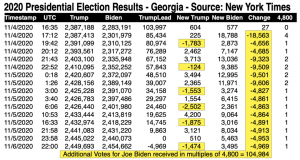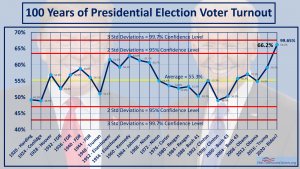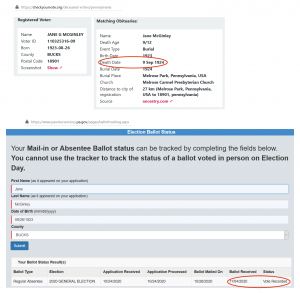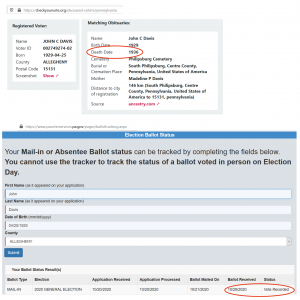 According to a Rasmussen poll conducted November 17-18, 47% of all voters or 73 million Americans (155 million votes counted so far) believe the November 3rd presidential election was stolen from Donald Trump.
According to a Rasmussen poll conducted November 17-18, 47% of all voters or 73 million Americans (155 million votes counted so far) believe the November 3rd presidential election was stolen from Donald Trump.
This total includes 70% of Republicans who don’t believe it was a “free and fair election” and a stunning 30% of Democrats.
Many of us have been paying close attention to the attempts by Trump’s legal team to fight the “official” results in the courts. We believe Democrats fraudulently produced enough Biden votes (or eliminated Trump votes) in just a handful of counties in key battleground states to give those states and their electoral votes to the Democrat.
We know fraud occurred. There are now literally hundreds of evidential eyewitness testimonies and sworn affidavits showing illegal votes were cast and/or votes fraudulently tallied.
What I don’t know is — was that corruption widespread enough to flip the election to Trump.
I can only speak for myself so I’ll try to present the case why I have seen enough anecdotal or circumstantial evidence up to this point to conclude that — until I see information to the contrary — the presidential election was stolen from an incumbent president and that we are witnessing a (so far) bloodless coup.
Explosion of Mail-in Ballots
Much of this article will be on the Commonwealth of Pennsylvania where I lived and worked for many years and which was particularly problematic in this election.
But first we need to start with the U.S. Constitution. Under Article II only the legislatures of states can define what constitutes a legal vote. Not the governor, not the secretary of state and not the supreme court of a state. The only constraint the legislature has is to abide by its state’s constitution which as we’ll see shortly appears to be an issue in Pennsylvania.

I can’t recall another presidential election in my lifetime that had so many delays and pauses. Much of this was due, of course, to the explosive use of “mail-in” ballots in addition to traditional absentee ballots in many states purportedly due to concerns about the pandemic.
Shortly before election day, Democrats were pleased they enjoyed a substantial lead with those who were likely to vote by mail. But they were simultaneously worried that the number of mail-in ballots that could be disqualified in the presidential election might replicate recent primaries which also saw many new voters submitting invalid ballots by mail.
This was a vulnerability that many Democrats believed needed to be remedied by election day. What they were concerned about was the historical fact that far more mail-in and absentee ballots are rejected due to legal errors than are ballots voted in-person.
USA Today published a study that showed in the presidential election of 2016 there were approximately 316,000 ballots rejected nationwide. This was very concerning to Democrats given the closeness of that election particularly in key battleground states.
Democrats also knew that, in looking at rejected ballots in past elections, Democrat voters make more mistakes than Republican voters and have their votes rejected disproportionately.
There are government-related problems as well. In New York City, 100,000 Brooklyn residents who had asked for absentee ballots received them with wrong names and addresses. Such ballots would ultimately be rejected.
NYC held a primary in June that gave Democrats a preview of the mail-in ballot problems they would have to deal with before the November election. The results were horrifying. 37% of all votes were cast by mail and of these, 84,000 ballots were lacking a signature, postmark or arrived past the deadline. This was 20% of all mail-ins!
For primaries held nationwide, a staggering 550,000 mail-in ballots were disqualified. In states were mail-in voting has been taking place for a number of years and where voters were much more familiar with the process, the rejection rate was still about one percent. Remember on November 3rd about 160 million were cast so if 1% are rejected that would be 1.6 million votes. Most Democrats knew these would be their votes.
So the Democrats’ mission was clear: get more of their voters to cast their ballots in person OR — find a way to cure the rejection rate for mail-ins. They appear to have opted for the latter.
National Peculiarities
Based on the election results thus far, Joe Biden is the most popular presidential candidate in the history of the United States; far more popular than Barack Obama.

Joe Biden may have forever changed the way national campaigns are run in the U.S. Until the last few weeks before the election, he held few campaign stops and didn’t have rallies at all. Certainly not in the traditional sense. The campaign events he did have were mainly held in parking lots with people remaining in their cars. He held some appearances in which he spoke to a camera and had media in attendance but few supporters.
Observations
- In 2012, NBC News reported that Barack Obama won re-election with a “record-low share of U.S. counties … a paltry 22%.”
In 2020, Joe Biden garnered over 23% more (15 million) votes than did Obama but only won 16.7% of counties. Who knew that Joe Biden was much more of a rock star than Barack Obama?
- Trump had highest percentage of non-white votes of any Republican in history.
- Trump received more votes than any previous president seeking reelection in history: 11 million more than in 2016. (By comparison, Obama got 3.5 million fewer votes in 2012 than he did in 2008.)
- Trump got the highest percentage of minority votes for any Republican since 1960.
- Trump increased his percentage among black voters by 50% from 2016.
- Trump increased his share of Hispanic votes by 35% from 2016.
- Trump lost key battleground cities like Milwaukee, Detroit, Philadelphia and Atlanta by margins which gave their respective states apparently to Biden, but Trump outperformed 2016 in other similar cities.
For example Trump won 22.6% of NYC’s vote. In 2016 he garnered only 17.9%. This was a 26% increase in city support for Trump. In blue collar areas like the Bronx, Trump increased his share of the vote by a staggering 67%.
- 95% of Republicans voted for Trump compared to 92% in 2016.
- Biden had over 450,000 votes in battleground cities that had no other down-ballot votes cast for anyone.
- Biden won less than 90% of black votes, a level most Democratic candidates have lost.
- Biden won 17% more votes than Obama did in 2008 but only won 524 counties to Obama’s 873.
Around 1AM on election night (into the early morning hours of Nov. 4) many swing states appeared to stop counting ballots. In most places observers were told to go home and they left processing facilities. But counting continued in many precincts. Suspicious “vote spikes” occurred in the early morning hours in Georgia, Michigan and Wisconsin.
At one point late on election night, Trump had leads of 100,000 votes in Wisconsin, 300,000 in Michigan and 700,000 in Pennsylvania. The precincts in each state that were slow to report were in the largest cities in each. By dawn on November 4th Wisconsin had flipped to Biden and Michigan did shortly afterward. Some days later Pennsylvania did and later Georgia as well.
Situations in Key Battleground States
PENNSYLVANIA
In Pennsylvania (and Georgia as well) the deck was stacked against Republicans from the onset. This past March, the Pennsylvania legislature made revisions to (constitutionally challenged) Act 77 (see below) regarding voting requirements due to COVID. It re-scheduled the primary election date and dealt with polling place crowding concerns. What the legislature did not do was alter the requirement for all absentee and mail-in ballots to be received by 8PM on election night under existing law.
Democrats sued. They said the election night deadline had to be extended. The PA Supreme Court (5 Democrats, 2 Republicans) ultimately sided with the Democrats on September 17th.
Stunningly, the PA Supreme Court also arbitrarily extended the deadline for which ballots could be legally received and counted until 5PM on November 6th. They made up this law out of thin air.
(Republicans appealed to the Supreme Court of the U.S. which voted 4 to 4 not to accept the appeal [Coney-Barrett had yet to be sworn in and Roberts voted with the liberals] so the PA SC ruling held. However, Justice Alito did order votes received after November 3rd be kept separate for future consideration [about 10,000 votes].)
Additionally, before election day the commonwealth’s secretary of state gave election workers specific instructions not to disqualify any ballot due to a signature problem. This directive was due to the June 2nd primary election in which 1.5 million Pennsylvanians voted by mail but over 26,000 ballots were tossed out due to “‘signature-related errors or matters of penmanship’” according to a lawsuit filed by the PA League of Women Voters and the Urban League of Greater Pittsburgh. The Democrat governor and attorney general were quick to settle the lawsuit as this was a way around the Republican legislature’s actions.
Under Pennsylvania law, the election code restricts access (inspection) to ballots prior to election day. In some of the larger counties which had mail sorting machines, Democrats ignored the code and weighed the ballots in advance to see which voters had failed to include the required inner secrecy sleeve. Democrat operatives then contacted these voters to allow them to “cure” their ballots so their votes would not be canceled.
This action violated the Equal Protection Clause also cited in Bush v. Gore. “Having once granted the right to vote on equal terms, the State may not, by later arbitrary and disparate treatment, value one person’s vote over that of another.”
- Joe Biden made up considerable shortfalls when totals were reported Wednesday (Nov. 4) morning. Biden had a 90% ratio make up in Pennsylvania for votes counted during the night. Many mail-in ballot envelopes which are supposed to contain signatures — were destroyed.
- There were historically low absentee ballot rejection rates. Political analyst Robert Barnes observes, “If the states simply imposed the same absentee ballot rejection rate as recent cycles, then Trump wins the election.”
- Truck driver Jesse Morgan signed an affidavit that on October 21st he drove between 144,000 to 288,000 completed ballots from Bethpage, New York to Lancaster, PA where he was told to take them to a facility that he knew could not process them.
Morgan said he knew they were completed ballots because he saw the envelopes had handwritten return addresses. His normal route took him from Bethpage to Harrisburg first, then Lancaster but after driving to and waiting for 6 hours in Harrisburg he was instructed to not offload the ballots and drive Lancaster. He was surprised because he knew Lancaster had no processing facility. He said he parked his trailer in the normal place and went home. The next day his trailer was gone.
The Amistad Project alleges that fraudulent ballots were mistakenly put on Morgan’s truck. These could not be permitted to be unloaded in any public setting that is why he could not offload in Harrisburg.
- The non-partisan United States Election Project reports that in Pennsylvania as of Nov. 20th, 2,629,672 ballots were returned. Of these just 7,411 were rejected for a rate of 0.3% (about 1 every 350 ballots).
Democrats had a 65% to 24% plurality in returned mail-in ballots.
In 2016, PA had about 266,208 absentee ballots of which 2,534 (about 1%) were rejected in line with historical norms.
A similar rejection rate this year in PA would have meant another 16,000 votes rejected.
A lawsuit filed by Congressman Mike Kelly and candidate Sean Parnell alleges that Pennsylvania’s Act 77, passed in October 2019, violates the state constitution. After injunctive relief was granted by Commonwealth of PA judge, Patricia McCullough, Pennsylvania’s Attorney General, Josh Shapiro, bypassed his appeal to Judge McCullough and took it directly to the PA Supreme Court.
The Pennsylvania Supreme Court overruled Judge McCullough and tossed Kelly and Parnell’s lawsuit essentially stating that it was filed too late since the election was already over and this was nothing but sour grapes from the election losers. (Had the plaintiffs filed before the election it is likely they would have been told they had no standing because the election had not even been held so they may have had no due process at all.)
The case was appealed to the Supreme Court of the United Stats after the rejection with prejudice by the PA Supreme Court.
The key claim in the lawsuit is that when Act 77 expanded eligibility for absentee voting, it was an illegitimate amendment the state’s constitution.
Section 14 (a) of the PA constitution on voting says absentee eligible voters are those who are “…unable to attend at their proper polling places because of illness or physical disability…” An amendment was added in 1967 that specified the only reasons a voter could qualify for an absentee ballot: “1) the voter will be absent from their municipality because duties, occupation, or business needs require them to be elsewhere; 2) illness or physical disability; 3) observance of a religious holiday, and 4) due to status as a county worker.”
These specific qualifications were bypassed by the legislature, the governor and the state supreme court when Act 77 was adopted. It appears clear to a layman like myself that you can’t amend the state’s constitution by disenfranchising its citizenry who are to vote on any proposed constitutional change.
The suit appeared to have merit … but late today (Dec. 8) SCOTUS issued a one sentence statement: “The application for injunctive relief presented to Justice Alito and by him referred to the Court is denied.”
GEORGIA
Georgia also had serious issues with the integrity of its vote. Like in Pennsylvania, Democrats (led in Georgia by Stacey Abrams) also sued the state over mail-in ballot procedures. The Kemp (Republican governor) administration settled (surrendered) the lawsuit with Abrams over a key change which said mail-in ballots only had to match the signatures on the applications which were not secure, not the signatures for the registered voter on record. This opened up the entire absentee system for fraud.
Georgia had some bizarre situations that individually might do little more than raise an eyebrow but collectively are more than slightly suspicious.
Shortly before noon on Wednesday, Nov. 4, Biden made up a 104,000 vote Trump lead over the next 28 hours. There’s nothing necessarily extraordinary about this except the statistically unusual batch postings over that time period.
The chart below was published by City Central News and shows that from 11:35AM EST on Nov. 4 (UTC time is 5 hours ahead of EST) there were 15 vote dumps that each had Biden gaining in increments of 4,800 votes.  This wasn’t the number of votes for Trump or Biden, it was the gains for Biden that were bizarre. Each vote dump was within ±3.5% of 4,800. The erosion of Trump’s lead was not just due to Biden gains. In 3 of the dumps, Trump actually had votes taken.
This wasn’t the number of votes for Trump or Biden, it was the gains for Biden that were bizarre. Each vote dump was within ±3.5% of 4,800. The erosion of Trump’s lead was not just due to Biden gains. In 3 of the dumps, Trump actually had votes taken.
- In Fulton County, Biden won 100% of the 900 military ballots. Trump won the military vote 60% to 34% in 2016 and had a substantial lead over Biden with military personnel this year.
- Georgia had a mail-in ballot rejection rate even lower than Pennsylvania’s. Of the 1,320,154 mail-in ballots received just 2,689 (0.2%) were rejected.
There is a security video that was initially shown by Jacki Pick, a witness for the Trump campaign, at a Georgia’s Senate Judiciary Subcommittee hearing recently. It shows an election supervisor dismissing most of the election counters and observers at Fulton County’s State Farm Arena by about 10:30PM on election night. A few counters remained. The video went viral. Watch it here.
The video then shows cases being wheeled out from underneath a covered table, opened and the ballots contained therein processed.
A big tech supported (Google, Facebook and ByteDance, a Beijing-based company) “fact-checking” organization, Lead Stories, tried to debunk the video. It cited government officials stating there was no suspected fraud; that everything appeared normal to them on the video.
The Washington Post and Newsweek among others ran with the “debunking.” They concluded it was just another conspiracy theory by right-wingers.
Lead Stories regurgitated claims that the only people sent home election night were not counters but only those who cut open mail-in ballot envelopes in preparation for counting. Counters stayed and kept counting. This, Lead Stories says, is from the chief “investigator” for the Georgia secretary of state.
Georgia Republican Party Chairman, David Shafer, has consistently said that most counters and all observers were sent home after being told the counting would stop for the night and for them to return at 8:30AM the following morning when counting would resume. This assertion was backed up by the affidavits of two Republican observers.
It was also backed up by Regina Waller, the Fulton County public affairs manager for elections, who spoke with the media. She told ABC News that, yes, mail-in vote counters were in fact sent home around 10:30PM and were told to return at 8:30AM. This was backed up by NBC News and the Atlanta Journal-Constitution.
Many main stream media stories also included the purported reason why counting had to be put on hold. They reported it was because of a water pipe bursting. Some even said it was due to a water main break.
The “big” water problem was actually a urinal that overflowed during the morning of (and fixed later on) election day. So yes, observers and most counters were sent home but the reason for the dismissal was ridiculously flimsy.
Nothing was debunked. The video is what it appears. Counting continued into the night unobserved. Trump’s legal teams maintains that Georgia law requires ballot counting in public view.
The president’s campaign also filed a suit with Shafer that alleges there were tens of thousands of illegal votes counted in Georgia. The suit alleges that 2,600 felons, 66,000 underage registrants, 4,900 registered in another state, 40,300 who had moved to other counties without re-registering among others all voted illegally.
Recall that Biden “won” the state by just 12,670 votes.
Given that there will be a runoff election for the two U.S. Senate seats in Georgia it is important to note that had Republican Senator David Perdue received another 13,500 votes, he would have achieved the required 50% majority to win the election outright without requiring a runoff. This meant that these 13,500 votes would have prevented Democrats any chance of capturing the Senate.
MICHIGAN
There are currently 234 “pages of sworn affidavits alleging election irregularities from just one county in Michigan.”
Detroit poll worker Jessy Jacob filed an affidavit stating that on November 4th she witnessed “thousands of absentee ballots” backdated to make them appear valid though they had not arrived by the deadline. She also said that Detroit poll workers did not enforce voter ID verification.
- Mail-in ballot rejections were even worse in Michigan than in Pennsylvania or Georgia. Of the 2,481,696 ballots returned, the state disqualified just 1,856 for a rate of just 0.07%.
WISCONSIN
ABC News reported that over the last two election cycles — again, before the surge in mail-in ballots from inexperienced mail-in voters — that about 1.2% were disqualified. This year, 500,000 had been rejected nationally during the primary season, the first real test of expanded of the mail-in voting system.
Wisconsin which has yet to provide a mail-in rejection rate for the November election did disqualify 23,000 votes during primary voting which exceeded Trump’s margin of victory in the state in 2016 and Biden’s margin this year. Wisconsin’s mail-in ballots received and counted were twice the number of in-person voting totals.
ARIZONA
On December 7th, the Arizona Supreme Court agreed to hear an election challenge after an investigation of a random 100-ballot sample of votes in Maricopa County revealed that 3% were incorrectly counted. Two of the three ballots were removed from Trump’s legitimate total and the 3rd vote was removed from Trump and given to Biden.
TEXAS
Texas Attorney General Ken Paxton announced today (December 8, 2020) that the state is filing a lawsuit against four states, Georgia, Michigan, Pennsylvania and Wisconsin directly with SCOTUS alleging that the pandemic was used unlawfully to alter the results of the national election.
The press release: “Trust in the integrity of our election processes is sacrosanct and binds our citizenry and the States in this Union together. Georgia, Michigan, Pennsylvania and Wisconsin destroyed that trust and compromised the security and integrity of the 2020 election. The states violated statutes enacted by their duly elected legislatures, thereby violating the Constitution. By ignoring both state and federal law, these states have not only tainted the integrity of their own citizens’ vote, but of Texas and every other state that held lawful elections,” said Attorney General Paxton. “Their failure to abide by the rule of law casts a dark shadow of doubt over the outcome of the entire election. We now ask that the Supreme Court step in to correct this egregious error.”
The suit states that taking such unlawful acts have tainted not just the “integrity of their own citizens’ vote, but their actions have also debased the votes of citizens in Plaintiff State and other States that remained loyal to the Constitution.”
The lawsuit continues: “Without Defendant States’ combined 72 electoral votes, President Trump presumably has 232 electoral votes, and former Vice President Biden presumably has 234. Thus, Defendant States’ electors will determine the outcome of the election. Alternatively, if Defendant States are unable to certify 37 or more electors, neither candidate will have a majority in the Electoral College, in which case the election would devolve to the U.S. House of Representatives under the Twelfth Amendment to the U.S. Constitution.
We’ll see if the Supreme Court takes this case. It could be the justices intention to take this case superseded the Pennsylvania case which may be why they dropped that one. Time will tell.
Other Observations
- Bellwether states moved more strongly into Trump’s corner in 2020 than 2016. Florida, Ohio and Iowa defied the polls giving Trump significant victories in these states.
- Since 1900, in 31 presidential elections, Ohio and Florida have both gone against the eventual winner only once before 2020. That being in the disputed election of 1960.
- Ohio backed every winner since 1896 with the exception of 1944 and 1960. Florida picked 13 of 14 winners going back to 1964.
- Presidential challengers who win nearly always have considerable down-ballot coattails. Not Biden. Republicans won all 27 toss-up House elections, did not lose any state legislatures they retained control and even made gains in some states.
- Between 1980 and 2016 (10 elections), 19 of America’s 3,000 plus counties had a perfect record voting for each presidential winner. This year all were wrong with the exception of Washington’s Clallam County which backed Biden in 2020.
- Vigo County in Indiana fell the hardest. Going back to 1888 it failed only in 1908 and 1952. It voted for each winner since 1956 or the last 17 straight elections.
- Trump garnered 10 million more votes than he did in 2016. Not since Grover Cleveland lost in 1888 has an incumbent lost an election with more votes the second time around. (E.g., Obama received 5 million fewer votes in 2012.)
- Gallup’s last poll before the election said that 56% said they were better off than in 2016, just 32% said they were not. “No sitting president has lost re-election when more than half of the country is doing better than before the incumbent entered office.” Until 2020?
- Reagan, Bush 43 and Obama all won re-election with 45% or less believing they were better off than 4 years earlier. Biden’s victory based on nearly 6 in 10 believing they were better off than the sitting president is historically unprecedented.
- The performance of the S&P 500 in the three months preceding the election has been a strong indicator of the election results. It has an 87% success rate since 1928 and 100% since 1984. This indicator predicted a Trump victory in 2020 based on the market’s performance.
- Trump had a 30% “Enthusiasm Gap” advantage this summer according to pollster Scott Rasmussen. “Richard Baris, the director of Big Data Poll, told the New York Post in mid-October that enthusiasm for Trump ‘s historically high,’ while ‘Biden’s enthusiasm level is historically low.’” This was verified by the Trump rallies.
- Republican support for Trump was the highest for any candidate in either party since Eisenhower.
- Gallup’s approval rating had Trump at 53% just 12 days prior to November 3rd. As Gallup noted, “[A]ll incumbents with an approval rating of 50 percent or higher have won re-election, and presidents with approval ratings much lower than 50 percent have lost.”
A statistical analysis of the voter turnout also provides doubt about the validity/legality of each vote counted in this year’s election.
(UPDATED) A look back at the past 25 elections (100 years) going back to the victory of Warren Harding in 1920 is illustrated graphically (below). It shows the percentage of eligible voter turnout for each presidential election. As of late December 2020, the final count shows that 158,400,000 votes were cast for all presidential candidates.
 This means that the turnout for the 2020 election was 66.2%. The analysis shows that the turnout for this election statistically occurs about 1 in every 250 elections or 1 election every 1,000 years.
This means that the turnout for the 2020 election was 66.2%. The analysis shows that the turnout for this election statistically occurs about 1 in every 250 elections or 1 election every 1,000 years.
Impossibly high? No, but certainly highly improbable.
* * *
Donald Trump stands to lose this election by between 44,300 to 105,300 votes. Had Trump acquired this 44,300 vote plurality in Arizona (10,957), Georgia (12,670) and Wisconsin (20,682), both Biden and Trump would have 269 electoral votes which would send the election to the House of Representatives to decide the winner. Trump would likely prevail there due to each state’s delegation getting just one vote. Republicans lead by 26 – 21 with 3 tied or still undecided.
He could win the election outright by gaining 105,300 votes in Arizona, Georgia and Pennsylvania (81,700). This would give Trump 279 electoral votes to Biden’s 259.
Now a 105,300 vote deficit to make up is still a lot of votes though a small percentage of votes cast in these three states (0.7%) and infinitesimally small when viewed in comparison to the national vote total (0.07%). Whether one of these legal challenges succeed, no one knows at this point.
This article is already long and I didn’t even touch on the hundreds of affidavits and other potentially major questions — Dominion Voting Systems comes to mind. But I’ve tried to provide sufficient circumstantial evidence why I believe this election was fraudulently stolen. I’m apparently not alone as 73 million active American citizens believe as I do. If this is true, this was the first bloodless coup in American history — at least since 1960.
APPENDIX:
A site named “checkyourvote.org” examined 40,000 of the octogenarian Pennsylvanians who voted in the 2020 election at random and discovered that 533 of these 40,000 (1.33%) “voters” were already deceased. Here are just two of these dead voters, Jane G. McGinley (no relation) who died in 1924 at the age of one and John C. Davis who died in 1936 at the age of seven.


* * *
An affidavit signed by professor of Mathematics, Stephen Miller, PhD. performed an analysis of Republicans who had requested 165,412 mail-in ballots. These requests were never received nor counted.
Miller’s analysis statistically concludes that there is a 99.7% confidence level that mail-in “ballots requested by registered Republicans and returned but not counted range between 38,910 and 56,483.” (author’s emphasis)
The analysts called nearly 20,000 of these Republicans but for various reasons, (answering machines – 14k, refusing to talk – 3k and others) they were able to speak with 2,684 people and got responses. Based on these answers, between 24.2% and 32.6% said they did not request a ballot though one had been requested in their specific name. This amounts to between 40,900 to almost 54,000 ballots that were sent to someone other than the registered Republican who neither received nor voted the ballot.
- For a statistical analysis, there are plenty of data points so this provides a high degree of confidence.
- There is a 99.7% (3 standard deviations) confidence that between 37,000 and 58,900 ballots were requested by someone other than the named registered Republican.
- “Thus using the 99% confidence interval values we obtain that almost surely the number of ballots requested by registered Republicans and returned but not counted is in the range from 38,910 to 56,483.” (authors emphasis).

